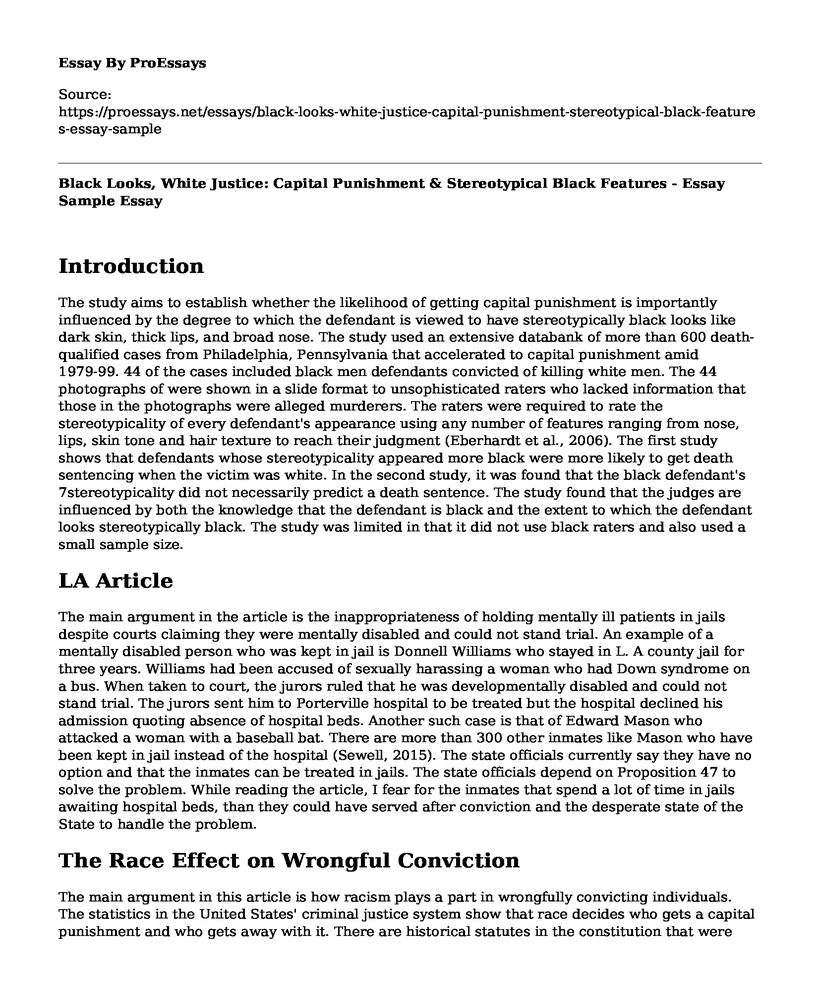Introduction
The study aims to establish whether the likelihood of getting capital punishment is importantly influenced by the degree to which the defendant is viewed to have stereotypically black looks like dark skin, thick lips, and broad nose. The study used an extensive databank of more than 600 death-qualified cases from Philadelphia, Pennsylvania that accelerated to capital punishment amid 1979-99. 44 of the cases included black men defendants convicted of killing white men. The 44 photographs of were shown in a slide format to unsophisticated raters who lacked information that those in the photographs were alleged murderers. The raters were required to rate the stereotypicality of every defendant's appearance using any number of features ranging from nose, lips, skin tone and hair texture to reach their judgment (Eberhardt et al., 2006). The first study shows that defendants whose stereotypicality appeared more black were more likely to get death sentencing when the victim was white. In the second study, it was found that the black defendant's 7stereotypicality did not necessarily predict a death sentence. The study found that the judges are influenced by both the knowledge that the defendant is black and the extent to which the defendant looks stereotypically black. The study was limited in that it did not use black raters and also used a small sample size.
LA Article
The main argument in the article is the inappropriateness of holding mentally ill patients in jails despite courts claiming they were mentally disabled and could not stand trial. An example of a mentally disabled person who was kept in jail is Donnell Williams who stayed in L. A county jail for three years. Williams had been accused of sexually harassing a woman who had Down syndrome on a bus. When taken to court, the jurors ruled that he was developmentally disabled and could not stand trial. The jurors sent him to Porterville hospital to be treated but the hospital declined his admission quoting absence of hospital beds. Another such case is that of Edward Mason who attacked a woman with a baseball bat. There are more than 300 other inmates like Mason who have been kept in jail instead of the hospital (Sewell, 2015). The state officials currently say they have no option and that the inmates can be treated in jails. The state officials depend on Proposition 47 to solve the problem. While reading the article, I fear for the inmates that spend a lot of time in jails awaiting hospital beds, than they could have served after conviction and the desperate state of the State to handle the problem.
The Race Effect on Wrongful Conviction
The main argument in this article is how racism plays a part in wrongfully convicting individuals. The statistics in the United States' criminal justice system show that race decides who gets a capital punishment and who gets away with it. There are historical statutes in the constitution that were racial. An example is North Carolina where there was a mandatory capital crime for instances where men of color were convicted for raping white females. Contrastingly, white men convicted of a similar crime would face a maximum of a year in the cells. The article also addresses cross-racial witnesses, where there is a high likelihood that witnesses from different races would find it hard to identify criminals from the other race. Again, the poor are more likely to be wrongfully convicted of a crime because of the notion that poor people are more likely to be criminals. Most of the people in American prisons (58.7%) are poor, with 41.2% of them being black (Rizer III, 2002). There is also institutionalized racism where regulations are made basing on who uses it. People found with crack cocaine were severely punished than those who used powder cocaine, since crack cocaine was more associated with blacks. While reading the article, the issues of racism and how the blacks are the ones majorly affected disturbs my mind since we are all human and no one chooses the skin they are born in.
References
Eberhardt, J. L., Davies, P. G., Purdie-Vaughns, V. J., & Johnson, S. L. (2006). Looking deathworthy: Perceived stereotypicality of black defendants predicts capital-sentencing outcomes. Psychological Science, 17(5), 383-386.
Rizer III, A. L. (2002). The race effect on wrongful convictions. Wm. Mitchell L. Rev., 29, 845.
Sewell, A. (2015). Defendants declared mentally incompetent face lengthy delays in jails. Retrieved from https://www.latimes.com/local/countygovernment/la-me-inmate-backlog-20150401-story.html
Cite this page
Black Looks, White Justice: Capital Punishment & Stereotypical Black Features - Essay Sample. (2023, Apr 28). Retrieved from https://proessays.net/essays/black-looks-white-justice-capital-punishment-stereotypical-black-features-essay-sample
If you are the original author of this essay and no longer wish to have it published on the ProEssays website, please click below to request its removal:
- "Strength of a Woman": Love Equals One Mary J. Blige Essay
- Diversity Democracy Dissent Essay Example
- Age-Related Effects and Medical Conditions That Affect Driving in Older Adults
- Research Paper on The Implication of Brown Versus the Board of Education to Modern Education
- Comparing Constitutional & Statutory Law: Similarities & Differences - Essay Sample
- Paper Example on Washington Supreme Court: Rule of Law & Court Structure
- Paper on Culture, Ethnicity, and Judith Butler: A Reflection







